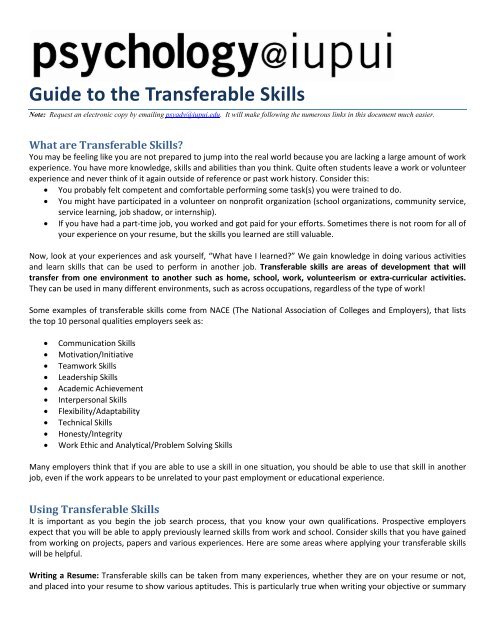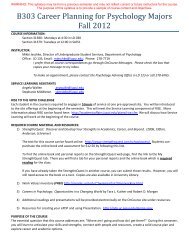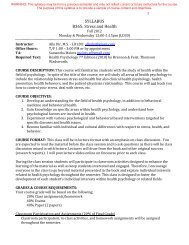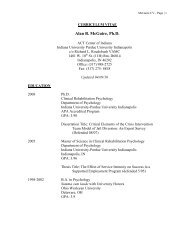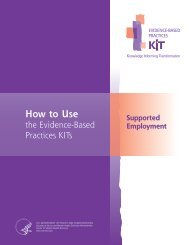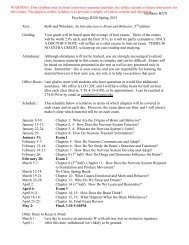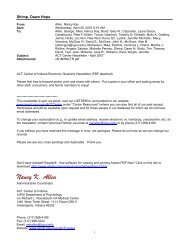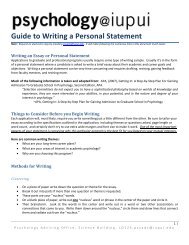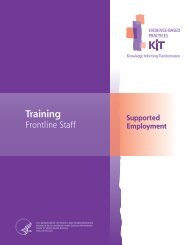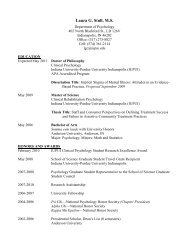Guide to the Transferable Skills
Guide to the Transferable Skills
Guide to the Transferable Skills
You also want an ePaper? Increase the reach of your titles
YUMPU automatically turns print PDFs into web optimized ePapers that Google loves.
<strong>Guide</strong> <strong>to</strong> <strong>the</strong> <strong>Transferable</strong> <strong>Skills</strong><br />
Note: Request an electronic copy by emailing psyadv@iupui.edu. It will make following <strong>the</strong> numerous links in this document much easier.<br />
What are <strong>Transferable</strong> <strong>Skills</strong><br />
You may be feeling like you are not prepared <strong>to</strong> jump in<strong>to</strong> <strong>the</strong> real world because you are lacking a large amount of work<br />
experience. You have more knowledge, skills and abilities than you think. Quite often students leave a work or volunteer<br />
experience and never think of it again outside of reference or past work his<strong>to</strong>ry. Consider this:<br />
• You probably felt competent and comfortable performing some task(s) you were trained <strong>to</strong> do.<br />
• You might have participated in a volunteer on nonprofit organization (school organizations, community service,<br />
service learning, job shadow, or internship).<br />
• If you have had a part-time job, you worked and got paid for your efforts. Sometimes <strong>the</strong>re is not room for all of<br />
your experience on your resume, but <strong>the</strong> skills you learned are still valuable.<br />
Now, look at your experiences and ask yourself, “What have I learned” We gain knowledge in doing various activities<br />
and learn skills that can be used <strong>to</strong> perform in ano<strong>the</strong>r job. <strong>Transferable</strong> skills are areas of development that will<br />
transfer from one environment <strong>to</strong> ano<strong>the</strong>r such as home, school, work, volunteerism or extra-curricular activities.<br />
They can be used in many different environments, such as across occupations, regardless of <strong>the</strong> type of work!<br />
Some examples of transferable skills come from NACE (The National Association of Colleges and Employers), that lists<br />
<strong>the</strong> <strong>to</strong>p 10 personal qualities employers seek as:<br />
• Communication <strong>Skills</strong><br />
• Motivation/Initiative<br />
• Teamwork <strong>Skills</strong><br />
• Leadership <strong>Skills</strong><br />
• Academic Achievement<br />
• Interpersonal <strong>Skills</strong><br />
• Flexibility/Adaptability<br />
• Technical <strong>Skills</strong><br />
• Honesty/Integrity<br />
• Work Ethic and Analytical/Problem Solving <strong>Skills</strong><br />
Many employers think that if you are able <strong>to</strong> use a skill in one situation, you should be able <strong>to</strong> use that skill in ano<strong>the</strong>r<br />
job, even if <strong>the</strong> work appears <strong>to</strong> be unrelated <strong>to</strong> your past employment or educational experience.<br />
Using <strong>Transferable</strong> <strong>Skills</strong><br />
It is important as you begin <strong>the</strong> job search process, that you know your own qualifications. Prospective employers<br />
expect that you will be able <strong>to</strong> apply previously learned skills from work and school. Consider skills that you have gained<br />
from working on projects, papers and various experiences. Here are some areas where applying your transferable skills<br />
will be helpful.<br />
Writing a Resume: <strong>Transferable</strong> skills can be taken from many experiences, whe<strong>the</strong>r <strong>the</strong>y are on your resume or not,<br />
and placed in<strong>to</strong> your resume <strong>to</strong> show various aptitudes. This is particularly true when writing your objective or summary
of skills at <strong>the</strong> <strong>to</strong>p of your resume (see <strong>Guide</strong> <strong>to</strong> Resume for more on this <strong>to</strong>pic). In a chronological resume, you can use<br />
transferable skills <strong>to</strong> highlight what you gained from individual experiences.<br />
Writing a Cover Letter: This is an area when you can really spotlight skills you have gained. Many people use <strong>the</strong> cover<br />
letter as an avenue <strong>to</strong> expand on specific details that would not fit in <strong>the</strong> confines of a resume. In <strong>the</strong> cover letter, you<br />
are asked <strong>to</strong> explain what makes you qualified for <strong>the</strong> position. Within <strong>the</strong> cover letter, you can compare <strong>the</strong> skills<br />
required for <strong>the</strong> position <strong>to</strong> your own skills. Doing a little research on <strong>the</strong> company may also help <strong>to</strong> know on what skills<br />
<strong>to</strong> elaborate. Check out our <strong>Guide</strong> <strong>to</strong> <strong>the</strong> Cover Letter for examples.<br />
Preparing for an Interview: In an interview, it is not so much what your experiences have been as it is how you<br />
communicate those experiences <strong>to</strong> your prospective employer. Many times in an interview, you will be asked <strong>to</strong><br />
describe what you have been involved in, how you contributed, and what you <strong>to</strong>ok from <strong>the</strong> experience. Also, many<br />
skills can be used in <strong>the</strong> actual interview. For example, many of your personal relations and communication skills will be<br />
important in expressing your thoughts and connecting with <strong>the</strong> interviewer. See <strong>Guide</strong> <strong>to</strong> Interviewing for more<br />
information.<br />
Represent Your <strong>Skills</strong><br />
The thing <strong>to</strong> remember is that having a degree does not guarantee a job in <strong>to</strong>day’s market. You must find <strong>the</strong> best way<br />
<strong>to</strong> present your qualifications in a multidimensional manner. You must convey yourself as a complete and well-rounded<br />
package. The fact that you have an education is a big bonus point for you. Now you have <strong>to</strong> successfully weave <strong>to</strong>ge<strong>the</strong>r<br />
your skills, experiences, academics, and personality traits that employers are looking for. Employer surveys indicate that<br />
a candidate’s experience is a key fac<strong>to</strong>r in getting hired. The strongest candidates have “real world” experience in cocurricular<br />
activities: co-ops, internships, practicums, part-time jobs, full-time jobs, service learning, and volunteering<br />
(from: The Career Center: University of Illinois at Champaign-Urbana).<br />
So, now <strong>the</strong> question becomes what qualifies as a transferable skill and how do I know if I have performed <strong>the</strong> task Use<br />
this list below <strong>to</strong> get you thinking in <strong>the</strong> right direction. These are samples representing one way you can categorize<br />
transferable skills, and are not all inclusive.<br />
*This list of transferable skills comes from <strong>the</strong> Richard Bolles’ What Color is Your Parachute, ed. 2002. The skills were<br />
categorized by <strong>the</strong> MU Career Staff.<br />
COMMUNICATION<br />
Communicating Men<strong>to</strong>ring Reporting Telling<br />
Editing Promoting Representing Translating<br />
Explaining Proofreading Responding Understanding<br />
Informing Providing Selling Verbalizing<br />
Interpreting Publicizing Sharing<br />
Lecturing Reading Speaking<br />
Listening Relating Talking<br />
CREATIVE<br />
Acting Drawing Interpreting Publicizing<br />
Composing Expressing Inventing Rendering<br />
Conducting Founding Modeling Shaping<br />
Creating Generating Originating Showing<br />
Designing Illustrating Painting Singing<br />
Detailing Imagining Performing Sketching<br />
Developing Improvising Pho<strong>to</strong>graphing Symbolizing<br />
Displaying Initiating Playing Writing<br />
Dramatizing Innovating Printing
HELPING AND TEACHING<br />
Advising Guiding Processing Teaching<br />
Coping Helping Referring Tending<br />
Counseling Instructing Rehabilitation Training<br />
Empathizing Mediating Resolving Tu<strong>to</strong>ring<br />
Giving Offering Serving<br />
MANAGEMENT AND LEADERSHIP<br />
Addressing Heading Negotiating Recruiting<br />
Arbitrating Implementing Ordering Separating<br />
Coaching Influencing Overseeing Supervising<br />
Consolidating Informing Persuading Team Building<br />
Controlling Inspiring Piloting Umpiring<br />
Coordinating Instituting Planning Unifying<br />
Deciding Integrating Prescribing Uniting<br />
Devising Interviewing Presenting Upgrading<br />
Directing Judging Programming<br />
Diverting Leading Protecting<br />
Enforcing Managing Recommending<br />
ORGANIZATIONAL AND FINANCIAL<br />
Administering Defining Logging Retrieving<br />
Arranging Detailing Manipulating Reviewing<br />
Auditing Dispensing Moni<strong>to</strong>ring Schedule<br />
Budgeting Distributing Organizing Selecting<br />
Calculating Estimating Preparing Sorting<br />
Checking Filing Projecting Summarizing<br />
Classifying Financing Purchasing Supplying<br />
Collecting Ga<strong>the</strong>ring Raising Systematizing<br />
Compiling Inven<strong>to</strong>rying Reconciling Transcribing<br />
Computing Keeping Recording Typing<br />
RESEARCH<br />
Analyzing Disproving Interpreting Researching<br />
Ascertaining Dissecting Intuiting Solving<br />
Assessing Evaluating Learning Studying<br />
Charting Examining Observing Synergizing<br />
Conceptualizing Experimenting Predicting Syn<strong>the</strong>sizing<br />
Detecting Formulating Problem Solving Testing and Proving<br />
Determining Hypo<strong>the</strong>sizing Processing Troubleshooting<br />
Diagnosing Indentifying Questioning Weighing<br />
Discovering Inspecting Reasoning<br />
TECHNICAL<br />
Assembling Extracting Making Sewing<br />
Building Fixing Operating Treating<br />
Conserving Handling Producing Washing<br />
Constructing Installing Repairing<br />
Digging Lifting Setting<br />
Driving Maintaining Setting Up
OTHER SKILLS<br />
Achieving Expanding Obtaining Taking Instructions<br />
Adapting Following Perceiving Traveling<br />
Anticipating Getting Realizing Understudying<br />
Attaining Having Responsibility Receiving Undertaking<br />
Completing Improving Reducing Using<br />
Delivering Increase Remembering Utilizing<br />
Eliminating Memorizing Risking Winning<br />
Establishing Navigating Sensing Working<br />
Map it Out<br />
Start with one job or volunteer experience you have been involved with. Break down <strong>the</strong> major tasks that you<br />
performed. Then divide each task in<strong>to</strong> <strong>the</strong> skills that you acquired from performing that task (Charts from What Color is<br />
Your Parachute Richard Bolles ed. 2002).<br />
Job 1<br />
Task A<br />
Task B<br />
Task C<br />
Skill 1 Skill 2<br />
Skill 1 Skill 2<br />
Skill 1 Skill 2<br />
This approach will help you in thinking about job descriptions for chronological resumes, responses <strong>to</strong> interview<br />
questions, and comments <strong>to</strong> add <strong>to</strong> your cover letter. If you group experiences from which you have derived similar<br />
skills, you can develop a skills and competencies section for resume and answers <strong>to</strong> behavioral interview questions.<br />
Do not think about a job or experience based on what you did, but ra<strong>the</strong>r what you gained and learned that a future<br />
employer may be looking for. After all, an employer will be evaluating you based on what you can do for his/her<br />
company; your past experiences are a means <strong>to</strong> determine whe<strong>the</strong>r or not your contribution would be positive, not an<br />
end.<br />
Consider what skills will be <strong>the</strong> most meaningful for <strong>the</strong> job you are investing. Do not get trapped in<strong>to</strong> simply explaining<br />
your qualifications by what you did for your past employer.<br />
Here is an example:
Server<br />
Take orders<br />
Put foodorders in<br />
Deliver food <strong>to</strong><br />
table<br />
Take payment<br />
Explained menu<br />
options -<br />
Interpersonal<br />
Communication<br />
Suggested options<br />
<strong>to</strong> guest - Sales<br />
Relayed orders <strong>to</strong><br />
cooking staff -<br />
Teamwork<br />
Accurately<br />
distributed food -<br />
Organization<br />
Managed various<br />
amounts of money<br />
- Cash Handeling<br />
Adapted from Missouri University Career Center. (2010). Career Specialist Training Manual Appendices. Also available at<br />
http://career.missouri.edu/handouts. Special thanks <strong>to</strong> MU for freely sharing <strong>the</strong>ir resources.


